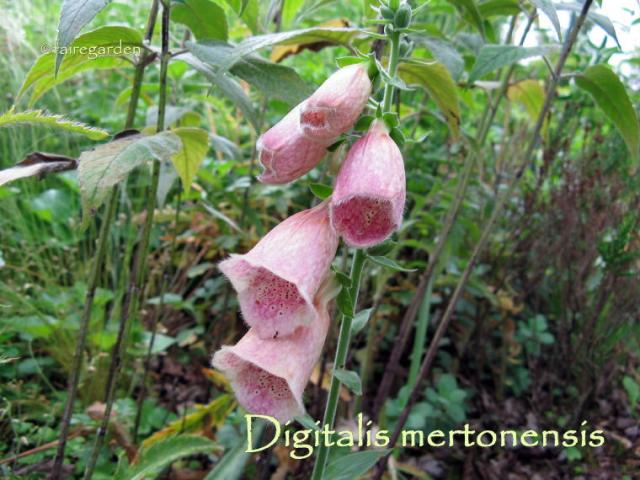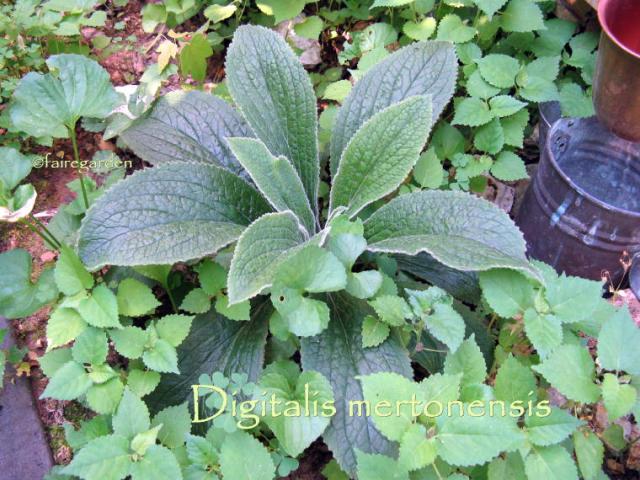
Foxgloves, Digitalis ssp. are among the favorite plants growing in the Fairegarden.

It is not only the verticality they offer in a sea of sameness, but the flowers themselves, opening from the bottom of the stalk.

It is not only for the humans that these flowers are scattered throughout the garden, by human placement and their own seed scatterings. The pollinators love the fairy (wee folks) gloves, including insect and magical pollen twizzlers. ‘Folks gloves became foxgloves long ago.

It is not only Digitalis purpurea that is grown here, seeds successfully sown in the greenhouse of Digitalis parviflora ‘Milk Chocolate’ have produced garden flowers. Two plants from over a dozen planted out bloomed in 2010. It is hoped that the rest will bloom next year. Seeds were gathered and sown in situ from the two stalks.

The flowers are quite small but numerous, and do resemble that sweet chocolatey confection. Although I prefer the dark chocolate, sixty percent cocoa for consumption, these flowers are sublime.

A Knoxville nursery had Digitalis obscura offered in four inch pots this spring. We bought all they had, of course. A few perished in the drought of summer so it was good that there were extras. One plant bloomed, it is hoped there will be a better showing next year and seeds can be obtained and sown.

The Strawberry Foxglove, Digitalis mertonensis is more of a perennial than D. purpurea, with fuzzier, consistently pinkish flowers and shorter habit.

Time to talk about seeds. The most common of the Digitalis are biennials, meaning the foliage appears the first year from seed sowing and the blooms appear the next, in most cases, then the plant dies. I have had some foliage take two years to bloom, growing to a much larger size with larger and more flowers, as in the first photo of this post of a Digitalis purpurea volunteer. Even the so-called perennials are short lived, so to continue having them in one’s garden, seeds must be saved and/or scattered as they mature. When the seedpods have browned, dried and opened is the proper time to scatter. As always, nature does the best job of handling procreation without human interference. The seedlings can be easily moved in cooler months to the desired garden locations, or left alone for a bit of design serendipity.

There are many more species and named varieties of Digitalis than we are now growing, it was decided that needed to be rectified. An order was placed to the seed company across the pond, Chilterns. We do love getting Royal Mail. Here are the seeds ordered:
Digitalis:
ferruginea
lanata
ambigua
obscura
micrantha
nervosa
viridiflora
‘Flashing Spires’
thapsi
stewartii
trojana
‘Red Skin’


Planted in neat rows and well labeled, covered with recycled nursery flats for protection against digging felines, rodents and anything slithering around the raised box at the side of the shed, the seeds await nature to take her course. Rain would help immensely.
A page on my sidebar has been created to join the other Plants We Grow series for Digitalis. It is hoped that one day some or all of the above seed list can be photographed and added to the page.
Digitalis already growing here:
grandiflora ‘Carillon’
purpurea-various
parviflora ‘Milk Chocolate’
mertonensis
obscura
There was a post about Foxgloves that was written early in our blogging career, if you are interested, that can be seen by clicking here-Foxgloves.
Frances












Hi Frances, you really have a lot of foxgloves. Good luck with all those seeds. Did you know that the spots in the blooms are fairy footprints left from them sleeping inside? That’s what Thorn Goblinfly told me, anyway.
Carol, May Dreams Gardens
I have long loved foxgloves, for some reason they have never loved me and wintered over in my garden, at least until this one. They love it at Kilbourne Grove, and seed around for me, at least the purpurea does, the only variety I have. But now that they are happy I am going to check out other varities, now I am off to Chilterns.
Lovely post Frances about one of my favorite plants, I have quite a few varieties here, but I am not always successful in getting them to germinate. Love the image of your little foxglove seed beds.
K
I had no idea that there were so many different varieties of digitalis! I am growing foxgloves from seed for the first time and truly hope to see such beautiful flowers as yours…eventually.
That photo with the bee and the foxglove flowers is stunning!
Those foxy gloves are marvelous. I haven’t had luck with them yet. Seeing this post makes me want to try again. We are having RAIN this morning. WHoooooo Hooooooo. Almost an inch predicted. Keep your fingers crossed for us.
Frances, great post. I love foxgloves and they seem happy in my garden, I really must get some more varieties. I have purpurea and one other, definitely more needed! I buy Chiltern seed as well and have some foxglove seedlings ready to plant out but they will have to wait until after my holiday!
Best wishes Sylvia (England)
Dear Frances, I so want to get them established here~They make me smile and to realize there are so many different varieties with charming flowers and different looking foliage is exciting. Surely one will like C&L! I have one little plant that survived out of the three I brought home this spring~I suspect it’s a D purpurea and has a little bloom right now. Wish me luck with it and seeds I’m sowing near this happy plant! xxxgail
I love those chocolate foxgloves. Are they perennial, biennial? Also, thank you for that link to Chiltern Seeds.
Wow, you certainly have a collection. I just have Grandiflora and it blooms in the spring for just a short time. I have never had it rebloom even though it does at times. I do like them because they come up in the middle of other plantings. Oh, to have more room.
Eileen
No idea there are so many varieties! Thank you for this post. I’m anxious to try a few more. But I will have to be patient… not many more weeks until a blanket of snow will cover my gardens.
Foxgloves were a part of the wild garden of my childhood, so it pains me that I lost the ones I planted here. You’ve inspired me to try again, but with mertonensis. Maybe that will fare better. Next time you place an order for seeds across the Pond, can you include a couple things for me?
I love foxgloves too and grow several varieties here in the Sandbox. Loved the idea of the upside down trays. Why didn’t I think of that. Duh!!!
Oh how I love this plant, and you have quite a variety! The grandiflora I have is reblooming now, and a few tardy purpureas are blooming too. The very bestest for me is definitely the purpurea ‘Excelsior’ some growing to 6-7 feet this year. I’ll enjoy seeing how your seeds turn out, especially ferruginea.
I’m surprised that Digitalis will grow in your climate, thought the summers would be too hot. Also didnt think Chilterns would export to you given your worries about taking seeds back in May. I do love your collection and will be exploring digitalis more
Thanks for this excellent lesson on foxgloves, Frances. I knew they were biennials, but I mistakenly thought the blooming ones I bought three years ago would return and bloom this year. Now I know why they didn’t come back:) I love those little fairy bell blooms; time to order some seeds!
Hi Frances, Digitalis is a biennial (at best) here… sometimes not even making it to the second year. Obviously I’ve not had the good fortune to have it reseed. I think I’ll start some in a Winter milkjug greenhouse this year!
Wow, I had no idea there were so many different Digitalis! I sometimes buy a sixpack at the nursery, and usually half survive and bloom in my fairly dry garden – even under the redwoods, it’s not that moist. But they sure are beautiful. Maybe next spring, I’ll get another batch.
Wonderful blog. Am so glad that I just found it.
Lots of greetings from Denmark
AUNTIE GREEN
One of my all time favorites. Yours are beautiful, I can’t wait to see them bloom again. We had a great few years around here, when the foxgloves decided to bloom in our condo garden. All the old English people were disturbed by them, but I was hoping they would take over. Ha.
Jen @ Muddy Boot Dreams
I just planted foxglove yesterday in my front bed. I can only hope they do as well as yours.
Thanks Frances. I will take your advice. Some stalks already have produced. Just waiting to seed them in. I would have not done this without you suggesting it. I am doing it with sweet peas, that are volunteers from my neighbors yard. She never trims or cuts back anything. So they finally crawled their way over to my tiny yard. Hooray.
I love foxgloves and used to have some but since the weather has got hotter and drier they don’t seem to work in my garden. Which means I have enjoyed this post all the more!
I have wanted to grow foxgloves here in my garden. Must try them next Spring. I love the way they bloom.
A most enjoyable post Frances. I am a dark chocolate girl too but think that I could be tempted by ‘Milk Chocolate’. Reading your post has acted as timely reminder that I want to place an order with Chiltern Seeds – might just be adding one or two packets of foxgloves seeds 🙂
What a wonderful variety of foxgloves you grow Frances! Thanks for the scoop on Chilterns – looks like a wonderful resource for seeds.
We grow grandiflora here and like that it’s so reliably perennial. The small footprint of foxgloves makes it so easy to tuck them in. I’ve long wanted to add purpurea and try the more showy varieties than grandiflora – thank you for the inspiration.
I need to borrow Joy’s plant shoehorn.
I love foxgloves…have a hard time getting them to come back in Oklahoma..I love the pink blooms! Wish I had a whole garden of them..yours are sooo beautiful!! Miss Bloomers
I love foxglove…each variety has a charm of it’s own. I have a white one that is a reliable perennial for me…any idea what it might be?
Pingback: Growing Food In The Fairegarden « Fairegarden
Pingback: Foxgloves, Folk’s Gloves « Fairegarden
Pingback: What Looks Good Now-For Future Reference | Fairegarden